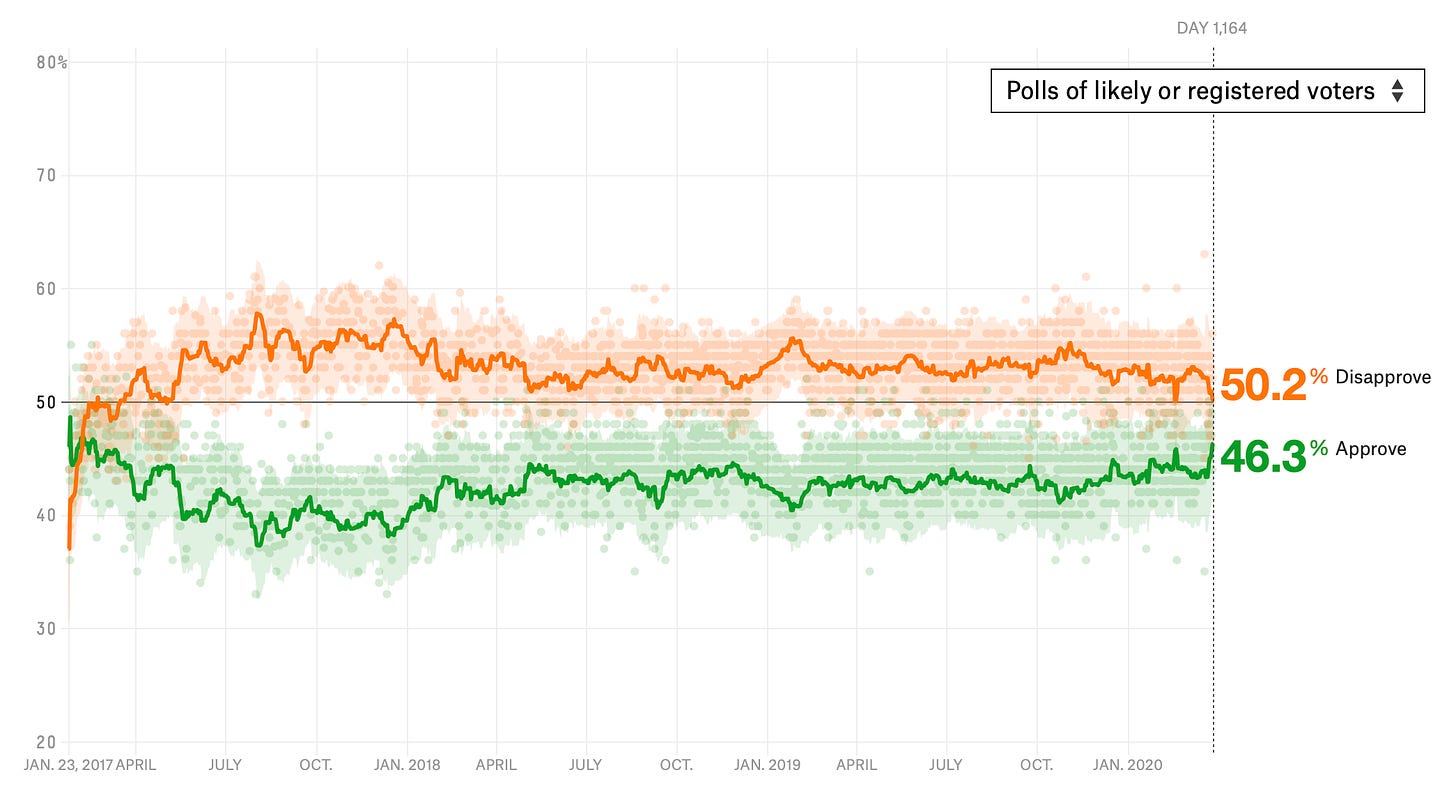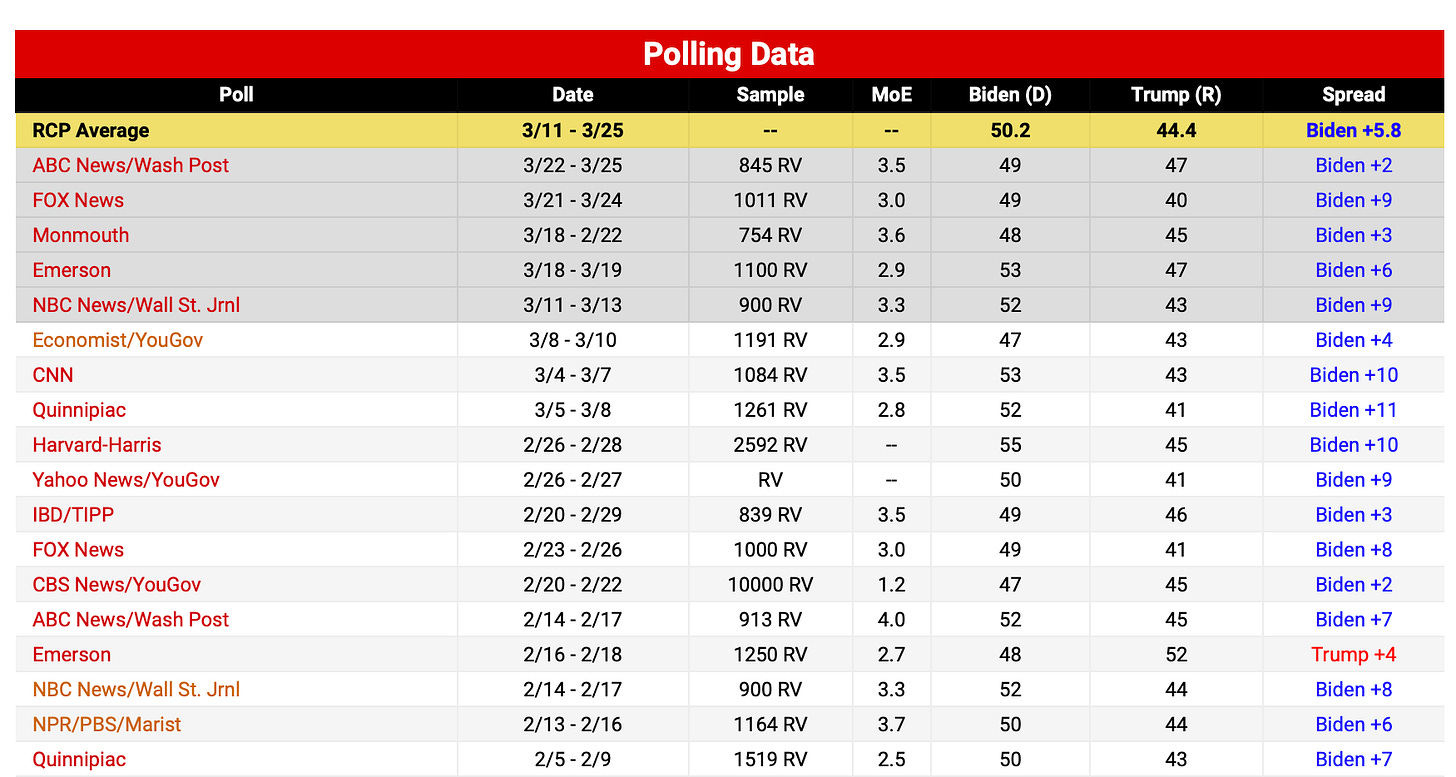What polls do (and don't) say about November 📊 March 29, 2020
Everybody just needs to take a deep breath
Welcome! I’m G. Elliott Morris, a data journalist at The Economist and blogger of polls, elections, and political science. Happy Sunday! This is my weekly email where I write about politics using data and share links to what I’ve been reading and writing.
Thoughts? Drop me a line (or just respond to this email). Like what you’re reading? Tap the ❤️ below the title and share with your friends! If you want more content, I publish subscriber-only posts 1-2x a week.
Dear reader,
I have seen a lot of sensationalism about polls recently. An ABC/Washington Post poll came out today showing Trump’s approval rating among all voters at 48%, above his disapproval rating of 46%. Twitter absolutely lost its mind, some even proclaiming Biden’s campaign a casualty of the coronavirus.
A note of caution is in order.
My email will be about electoral politics this week. I know there are a million other things going on right now—among them a deadly pandemic, an oil price war with Saudi Arabia, and millions of people losing their livelihood—but I’m going to stick with what I know today. When I do have something novel and noteworthy to write about covid-19, I will be sure to share it here, but I’d rather not share more noise.
What polls do (and don't) say about November
Everybody just needs to take a deep breath
Look, this really isn’t that hard. We’re 219 days out from the general election and polls, by and large, show Joe Biden with a large but surmountable advantage over Donald Trump. When you factor in the electoral college, the president has an even clearer path to re-election. Yet not much has actually changed over the past month.
Sure, the president’s approval ratings have increased. But that’s to be expected. In times of crisis, the public looks to someone to lead. And historically, these so-called “rally-around-the-flag” effects have tended to be larger than the ones Trump has apparently received. That says something interesting about the constraining influence of partisan polarization, but we’ll save that subject for another day. (All you need to know now is that I mean partisanship gives Trump a pretty high floor for his approval ratings—but it also means he has a low ceiling.)
Yet the bounce in his approval ratings still leaves more Americans opposed to his presidency than in favor of it. The latest numbers from FiveThirtyEight show him underwater by 4 points among registered and likely voters:

By my math, a -4 net approval rating translates to winning about 50% of the two-party vote in November. That would be a helpful indicator if we weren’t in such turbulent times. We should expect Trump’s approval rating to fall back toward its long-term average as the effects of the coronavirus outbreak and initial rally behind Trump wear off. (That will probably come in the summer, long before the election.)
Yet we also have other (often more predictive) indicators of how the election will turn out. They say much less “this is a time of fundamental change” and more “actually, things are mostly the same”.
First, there’s the generic congressional ballot, which has held steady around a 7-point advantage for Democrats according to FiveThirtyEight’s tracking. I think the stability here is especially notable given the attention paid to Congress’s action on the crisis.
Then, we have the economy, which right now is pretty bleak for the president. Though keep in mind that you shouldn’t put 100% of your weight on employment or the S&P 500 going south; economic change this early has a relatively weak correlation to presidential approval (a margin of error of roughly 9 points on any predicted Democratic vote share).


And finally, there are actual trial-heat polls of the November general election. The aggregate of recently-published polls currently shows a 6-point advantage for Biden over Trump. A month ago, it was a 7-point advantage—not so large a decrease to warrant speculation, given how polls ebb and flow due to sampling and non-sampling error.

If you look beyond the president’s topline approval ratings, polls seem to be telling us that things aren’t actually that fluid right now. And that makes sense. We live in an increasingly polarized world, where most of us made up our minds about who to vote for months or even years ago. 95% of the public will vote for the candidate nominated by the political party they align with, and 85-90% will vote for the party they did last time.
Yet, we still don’t know a lot about November. The historical accuracy of polls taken this early is, to use a highly technical and methodologically rigorous word, mixed. Biden is ahead today, but his lead is not large enough to guarantee a win. That’s pretty much all we know:


Honestly, this far out, it’s probably more accurate to say plainly that the election just looks close than it is to make any definitive statement about who is favored to win or lose the popular vote—let alone the electoral college vote.
But we do know enough for me to say most of the hubbub made about the toplines today is not worth your time.
Posts for subscribers
March 28: Grandma or the GDP? A new paper illustrates the false choice presented by the president’s narrative
Links and Other Stuff
The president’s approval ratings and the economy
What should you pay attention to as a better indicator of election outcomes? Nate Silver had some good thoughts on the subject this week, and I wrote a methodologically rigorous investigation of the question for The Economist's US politics newsletter Checks and Balance. The best thing to do is just combine the two into one regression model. The verdict is that Trump is an underdog, but winning in November will not be impossible.
What I'm Reading and Working On
I’ve been thinking a lot about the Christian response to the coronavirus and how churches are responding. I’m sad that I’ll apparently miss Easter service this year, but there are also some really interesting questions to be asked about how religions have used illnesses and plagues to blame people for their sins. How many people think covid-19 is a sign from God? Who is he supposedly punishing? Etc.
Thanks for reading!
Thanks for reading. I’ll be back in your inbox next Sunday. In the meantime, follow me online or reach out via email if you’d like to engage. I’d love to hear from you!
If you want more content, I publish subscribers-only posts on Substack 1-3 times each week. Sign up today for $5/month (or $50/year) by clicking on the following button. Even if you don't want the extra posts, the funds go toward supporting the time spent writing this free, weekly letter. Your support makes this all possible!



